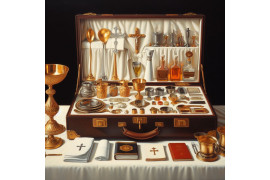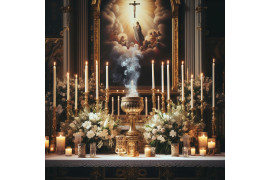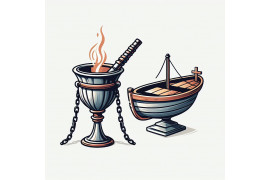During Benediction, priests often cover their hands when holding the blessed sacrament, the holy communion, or the holy Eucharist for solemn worship. This practice of solemn worship is rooted in reverence and respect for the holy communion, blessed sacrament, and holy Eucharist. By covering their hands, priests aim to add a sense of solemnity and mystery to the Benediction ceremony, where the blessed sacrament blesses the congregation.
The act of hand covering during Benediction is a symbolic gesture that emphasizes the priest's role as a conduit for blessings in the blessed sacrament. It is a solemn worship moment where the priest holds the golden monstrance. It is a blessing to reply with humility before the presence of the Eucharist, and it highlights the sanctity of the liturgical moment. The covered hands also draw attention to the monstrance itself, which holds the consecrated host for adoration and procession.
Historical significance of the humeral veil in Catholic rituals
The humeral veil has been an integral part of Catholic rituals for centuries. Its origins can be traced back to a practical need - to handle the sacred vessels and protect them from contamination. However, its use goes beyond mere functionality and carries deep symbolic significance.
Practicality and Protection
In the early days of the Church, when priests would hold the monstrance during Benediction, they realized the need for a protective covering. The humeral veil was introduced as a solution to this problem. It served as a barrier between the priest's hands and the sacred vessel, preventing any accidental contact that could tarnish its sanctity.
This practical aspect of using the humeral veil highlights the importance placed on preserving the holiness of these religious artifacts. By covering their hands with this beautiful cloth, priests ensure that no impurities or dirt come into direct contact with the monstrance or ciborium.
Symbolism of Intermediary Role
Beyond its practical purpose, there is a deeper symbolism associated with priests covering their hands while holding the monstrance. The use of the humeral veil signifies their role as intermediaries between God and His people.
In Catholic theology, priests are seen as representatives of Christ on Earth. They act as mediators between humanity and divinity, conveying God's grace and blessings to believers. When a priest covers his hands with the humeral veil, it represents his humility and recognition that he is not acting on his own authority, but rather carrying out God's work.
By concealing their hands beneath this sacred garment, priests emphasize that it is not their power or presence alone that brings forth blessings during Benediction. Instead, they acknowledge that they are conduits through which God's love and grace flow to His people.
Deepening Spiritual Connection
The use of symbols in religious rituals helps deepen believers' spiritual connection with divine mysteries. The humeral veil, with its historical significance and symbolic meaning, enhances the reverence and awe experienced during Benediction.
When a priest raises the monstrance covered by the humeral veil, it captures the attention of the congregation. This visual representation of Christ's presence in the Eucharist invites worshipers to direct their focus and devotion towards Him.
The covering of hands also denotes a sense of purity and respect for the sacred vessels. It reminds believers that they are in the presence of something holy and should approach it with reverence and humility.
Symbolism and spiritual meaning behind hand veiling
The practice of priests covering their hands when holding the monstrance holds deep symbolism and spiritual significance. Let's explore the reasons behind this tradition:
Humility and Unworthiness
One of the main reasons for hand veiling is to signify humility. By covering their hands, priests acknowledge that human hands are unworthy to directly touch or hold sacred objects like the monstrance. This act emphasizes the belief that these objects are holy and deserving of the utmost reverence.
Submission to God's Authority
Hand veiling also represents the priest's submission to God's authority. By covering their hands, they symbolize their role as servants of the Church, carrying out God's work on Earth. It serves as a visual reminder that priests are not acting on their own accord, but rather following divine guidance in their ministry.
Remembrance of Christ's Presence
Another important aspect of hand veiling is its connection to Christ's presence in the Eucharist. The monstrance contains the consecrated host, which Catholics believe is transformed into the body and blood of Jesus during Mass. By covering their hands while holding this sacred vessel, priests emphasize the profound mystery and awe-inspiring nature of Christ's real presence.
This tradition can be traced back to ancient times, when people believed that direct contact with sacred objects could bring about harm or defilement. In Jewish customs, for example, only certain individuals were allowed to handle sacred items like the Ark of the Covenant. Similarly, in Catholic rituals today, hand veiling serves as a way to show respect and preserve holiness.
While hand veiling may seem unusual or unfamiliar to those outside Catholicism, it plays an integral role in expressing reverence for sacred objects and acknowledging one's place before God. This practice aligns with other gestures seen in religious ceremonies worldwide, where individuals cover themselves or specific body parts as a sign of respect or acknowledgment of divine presence.
Exploring the need for hand covering during Benediction
Ensuring the Sanctity of Consecrated Hands
One reason why priests cover their hands when holding the monstrance during Benediction is to emphasize its sanctity. By using hand coverings, such as a humeral veil or a white cloth, priests ensure that only consecrated hands come into direct contact with the monstrance. This practice highlights the belief that these hands have been set apart for sacred duties and are specifically prepared to handle holy objects.
Maintaining Focus on the Eucharist
Covering their hands also serves to prevent physical contact from distracting worshipers' focus on the Eucharist itself. During Benediction, when the priest holds up the monstrance containing the consecrated host, it is believed to be a moment of profound reverence and adoration. The act of covering their hands helps in directing attention solely towards this sacred moment and away from any potential distractions caused by observing bare hands.
Emphasizing Priestly Role as Instruments of God's Blessings
Another reason for hand covering during Benediction is rooted in emphasizing that priests are merely instruments through which God's blessings flow. By concealing their hands, priests symbolically demonstrate that they are not acting independently, but rather serving as conduits for divine grace. This gesture reminds both priests and worshipers alike that it is ultimately God who blesses and sanctifies through them.
Preserving Ritual Tradition
The practice of covering hands during Benediction has been passed down through generations within religious traditions. It forms an integral part of liturgical rituals associated with worshiping the Eucharist. This tradition adds depth and significance to the ceremony while maintaining a sense of continuity with past generations who held similar beliefs about the sacredness of handling holy objects.
Respecting Cultural Customs
In some cultures, covering one's hands during religious ceremonies is seen as a sign of respect and reverence. By adhering to this custom, priests demonstrate their understanding and appreciation of cultural sensitivities. It also helps create a sense of unity and inclusivity among diverse communities, who may have different customs and practices.
Unveiling the purpose behind hand covering
Maintaining Cleanliness and Purity
One of the main reasons why priests cover their hands when holding the monstrance is to help maintain cleanliness and purity. Sacred objects like the monstrance are considered highly revered and are treated with utmost respect. By covering their hands, priests ensure that no impurities or dirt from their hands come into contact with the sacred object.
Preventing Unintentional Damage or Mishandling
Another important purpose behind hand covering during Benediction is to prevent any unintentional damage or mishandling of the monstrance. Human error or accidents can happen, and by covering their hands, priests provide an extra layer of protection for the sacred object. This helps to minimize the risk of dropping or damaging it in any way.
Adding an Element of Reverence
Hand covering also adds an element of reverence during Benediction. The act of visually separating ordinary actions from those performed during Benediction helps to emphasize its significance and sacredness. It sets apart this particular action as something special and deserving of reverence.
In addition to these primary reasons, there may be other factors that contribute to why priests cover their hands when holding the monstrance during Benediction:
-
Tradition: Hand covering during Benediction has been a long-standing tradition in many religious ceremonies.
-
Symbolism: The act of covering one's hands can symbolize humility and submission before God.
-
Ritualistic Practice: Hand covering may be part of a larger set of rituals performed during Benediction, each serving a specific purpose within the ceremony.
-
Aesthetic Considerations: Hand coverings may also serve an aesthetic purpose, enhancing the visual appeal and solemnity of the ceremony.
It is important to note that while hand covering is a common practice in many religious traditions, practices may vary slightly between different denominations or cultural contexts. However, regardless of these variations, the underlying intention remains the same - to show respect, maintain cleanliness, and protect the sacredness of the monstrance during Benediction.
Origins of hand covering in Benedictions
The tradition of priests covering their hands when holding the monstrance during Benediction has deep historical roots. This practice can be traced back to ancient Jewish customs and rituals involving the handling of sacred items in the temple. Over time, this custom was adopted and adapted by the early Christian Church, eventually becoming standardized as part of the Catholic liturgical tradition.
Ancient Jewish Practices and Temple Rituals
In ancient times, the Jewish people held a strong reverence for the sacred objects used in temple worship. They believed that these items were imbued with holiness and required special care and respect. When handling holy objects such as the Ark of the Covenant or other precious vessels, priests would often cover their hands with a cloth or wear gloves to protect them from direct contact.
Adoption by the Early Christian Church
As Christianity emerged and developed its own liturgical practices, it drew inspiration from its Jewish roots. The early Christians recognized the importance of reverencing sacred objects used in their worship ceremonies. They embraced the concept of hand covering as a way to show respect and honor for these holy items.
Standardization in Catholic Liturgical Tradition
Over time, hand covering during Benediction became an established practice within Catholicism. Benediction is a ritual where a consecrated host is placed in a monstrance—a decorative vessel—before being presented for adoration by the faithful. The act of covering one's hands while holding the monstrance during this ceremony symbolizes humility before God's presence.
The use of hand coverings varies among different religious orders and individual priests within Catholicism. Some may use simple white cloths or linen purificators to cover their hands, while others may opt for more elaborate gloves made specifically for this purpose.
While there are no strict rules governing hand covering during Benediction, it remains an important aspect of Catholic liturgy for many practitioners. It serves as a visual reminder of the sacredness of the Eucharist and the need for reverence in its handling.
Perspectives on the use of the humeral veil
The use of the humeral veil in Catholic liturgy has been a subject of varied perspectives and opinions. While some view, it as a beautiful symbol that enhances the sacredness and mystery of Benediction, others may see it as an unnecessary ritual that focuses more on the priest's actions rather than the essence of the Eucharist. Regardless of these differing viewpoints, the humeral veil remains an integral part of the Catholic liturgy for many.
Symbolic Beauty Enhancing Benediction
For some people, the humeral veil holds great significance and adds to the beauty and reverence of Benediction. It is often made from silk or other fine materials, adorned with intricate embroidery or designs. The purpose of this vestment is to cover the hands and shoulders of the priest while holding the monstrance - a vessel containing the consecrated Host - during Eucharistic adoration.
-
The humeral veil serves as a visual representation of humility and reverence towards Christ present in the Eucharist.
-
It signifies that it is not just an ordinary person holding up a vessel, but rather a representative acting on behalf of God.
-
The use of such elaborate vestments can create a sense of awe and wonder among believers, further enhancing their spiritual experience during Benediction.
Unnecessary Ritual or Distraction?
On the other hand, there are those who question whether using the humeral veil is necessary or if it simply distracts from the true essence of worship. They argue that focusing too much on external rituals can take away from one's personal connection with God.
-
Some believe that emphasizing physical gestures and symbols may overshadow deeper spiritual contemplation.
-
They argue that what truly matters is one's faith and devotion to God, rather than specific actions performed by priests.
-
In their view, removing such rituals could potentially allow individuals to engage more fully in prayer and reflection during Benediction.
Integral Part of Catholic Liturgy
Despite differing opinions, the use of the humeral veil remains an integral part of Catholic liturgy for many. It has been a longstanding tradition that holds profound meaning and significance within the faith.
-
The humeral veil is used during Benediction, a solemn ritual where the consecrated Host is displayed for worship and adoration.
-
Its purpose is to ensure that the sacred vessel containing the Eucharist is handled with the utmost reverence and respect.
-
By covering their hands and shoulders, priests symbolize their role as intermediaries between God and the people, emphasizing their sacred duty.
Reflecting on the significance of hand covering in holding the monstrance
In exploring the historical significance, symbolism, and spiritual meaning behind hand veiling during Benediction, it becomes apparent that the practice holds a deep-rooted purpose within Catholic rituals. The humeral veil, used to cover the hands while holding the monstrance, has been a tradition for centuries. Its origins can be traced back to medieval times, when priests would use veils as a sign of reverence and humility before God.
The act of covering one's hands signifies an understanding of the sacredness and holiness associated with the Eucharist. By concealing their hands beneath the humeral veil, priests demonstrate their unworthiness to touch or manipulate such a divine presence. It symbolizes their role as mere vessels through which God's grace is bestowed upon worshipers during Benediction.
As we delve deeper into this topic, it becomes evident that hand covering during Benediction serves not only as a visual representation of respect, but also as a way to protect both priests and congregants from any potential harm. The veiling ensures that direct contact between human flesh and the monstrance is avoided, preserving its sanctity and preventing any accidental mishandling.
To truly grasp the significance behind this practice, one must consider its historical context, symbolic meaning, and spiritual implications. Understanding these aspects allows individuals to appreciate the profound reverence associated with holding the monstrance while covered by a humeral veil.
Call-to-action: Delve further into Catholic rituals and traditions by exploring other practices that embody devotion and reverence towards religious symbols.
FAQs
Why do priests wear special garments during Mass?
Priests wear special garments called vestments during Mass to signify their role as mediators between God and humanity. These vestments carry symbolic meanings rooted in tradition and serve to enhance worship by visually representing different aspects of faith.
What is Benediction?
Benediction is a Catholic ritual that involves the exposition and adoration of the Eucharist, typically performed during a special prayer service. It is a time for worshipers to honor and worship the presence of Christ in the consecrated host.
What is the monstrance?
The monstrance is a sacred vessel used in Catholic liturgy to display and hold the consecrated Eucharistic host for adoration. It often takes the form of an ornate, gold or silver stand with a glass enclosure, allowing worshipers to see and adore the Blessed Sacrament.
Can anyone participate in Benediction?
Benediction is open to all members of the Catholic faith who wish to participate. It provides an opportunity for individuals to deepen their devotion and express reverence towards the Eucharist.
Are there variations in hand covering practices during Benediction?
While hand covering during Benediction is generally done using a humeral veil, variations may exist depending on cultural or regional customs within different Catholic traditions. These variations do not diminish the significance or purpose behind hand veiling, but rather reflect diverse expressions of faith.



